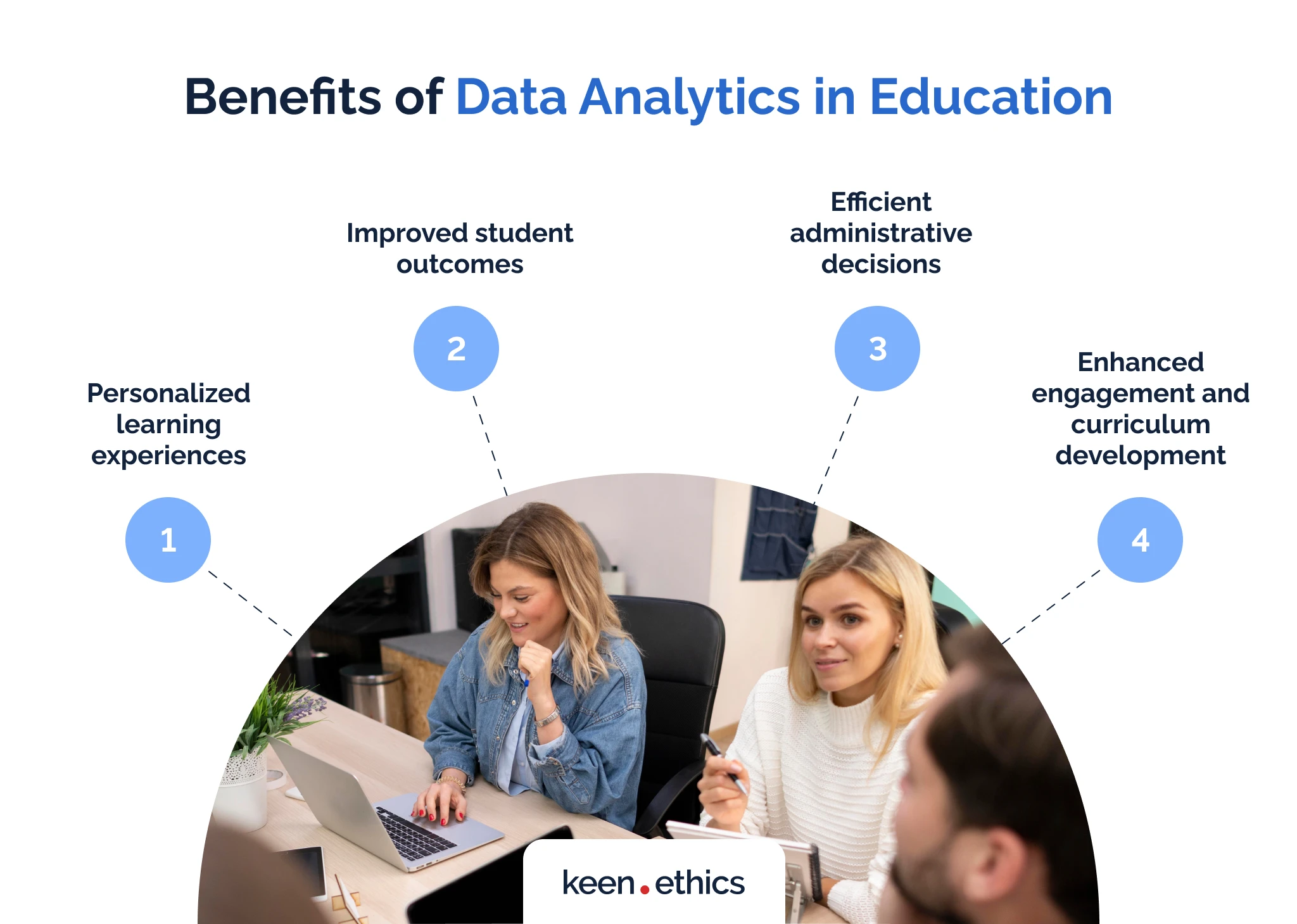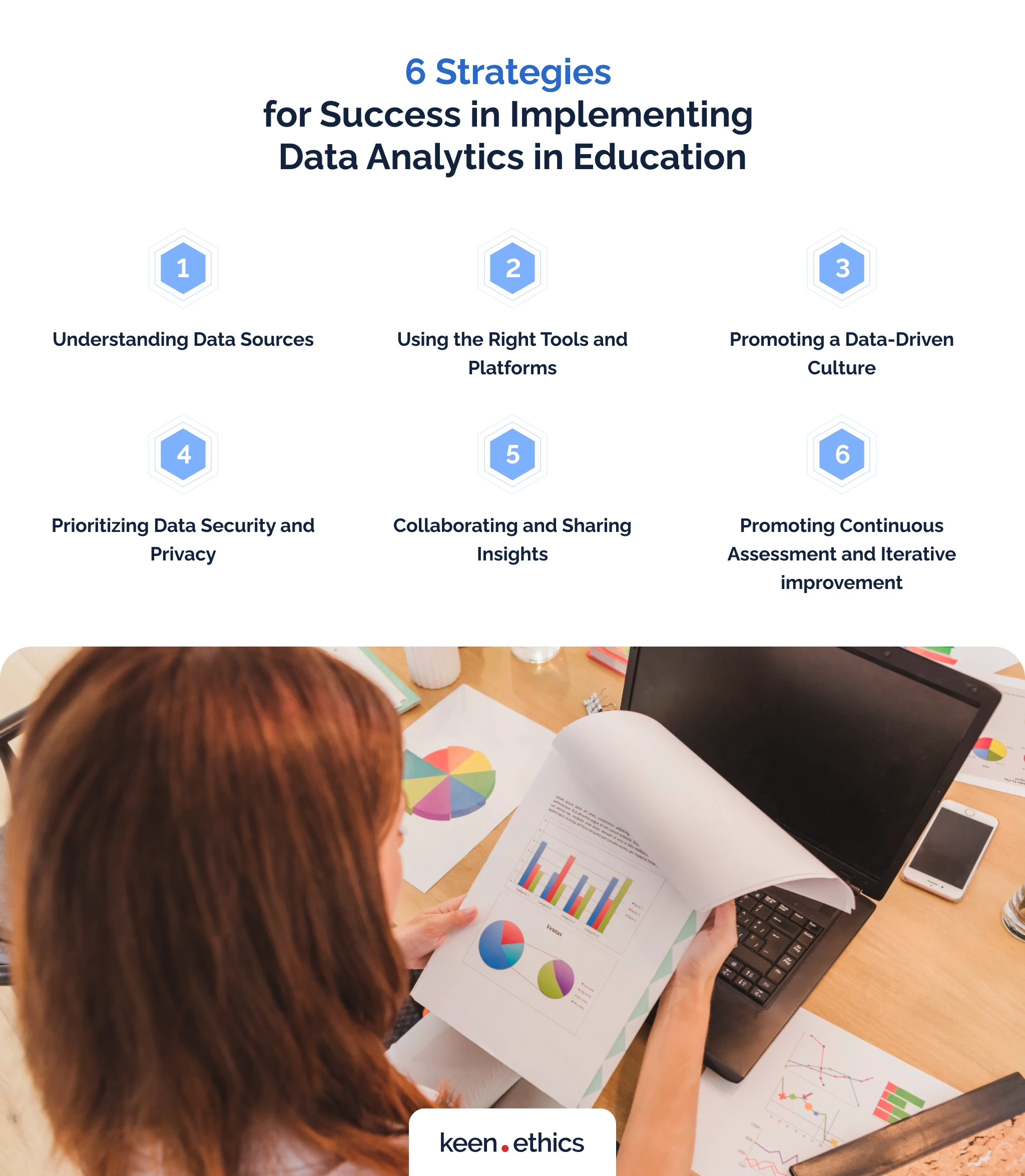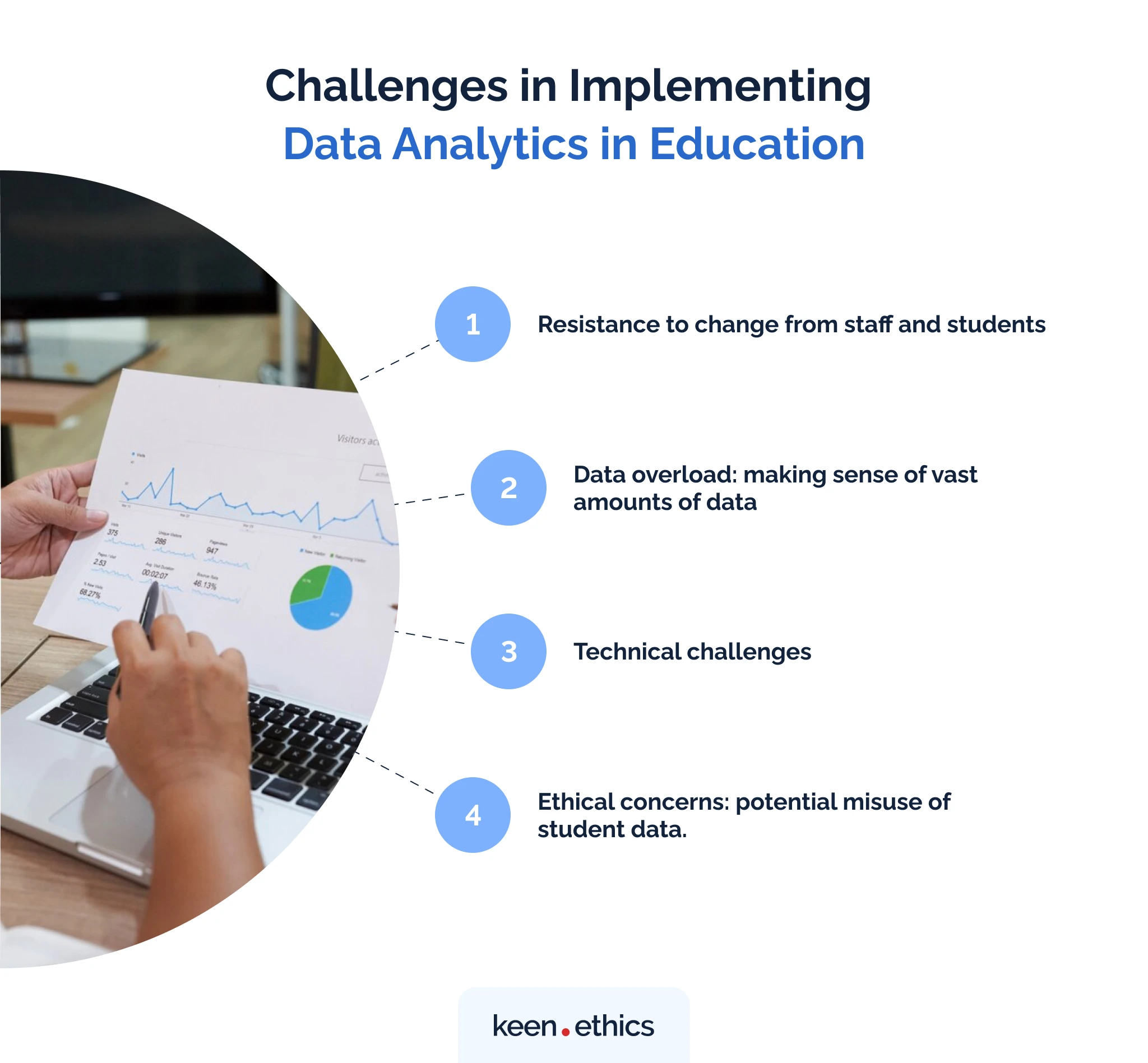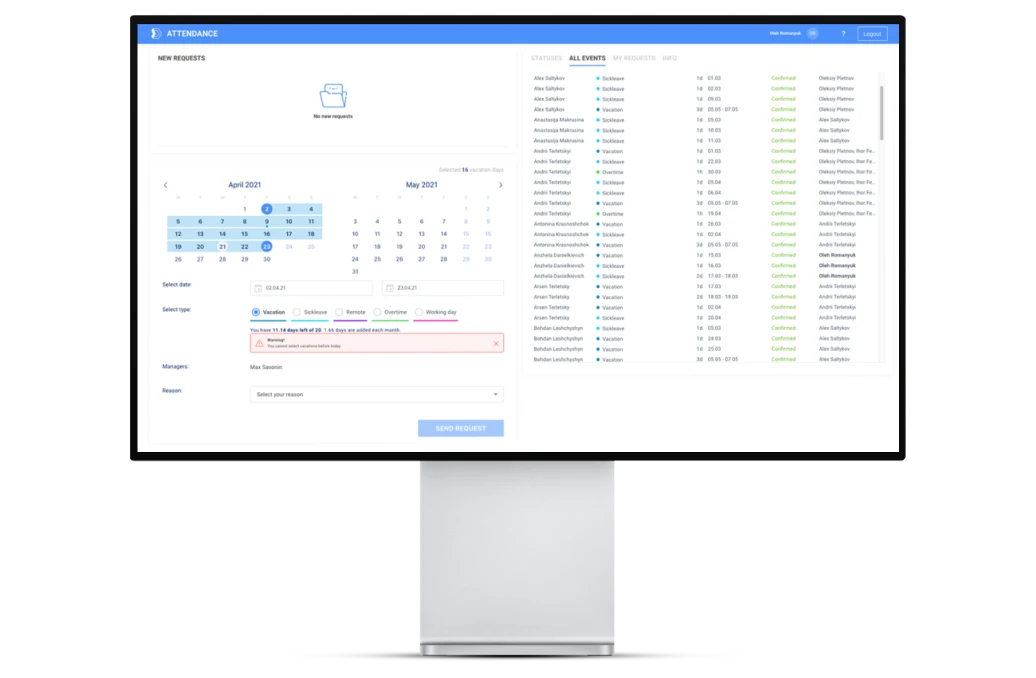Table of Contents
Do you want to learn about data analytics in education? This article reviews this topic and discusses how to implement the innovations in real-life scenarios.
What is Data Analytics and Big Data?
In this article, we review a consequence of the 1970s computer revolution, the rise of advanced data analytics in education. Computers enable humans to collect tremendous amounts of information about their activities. Now, we have Big Data that can transform our approach to education, governance, finance, and healthcare. Before we transition to further inquiries on the data analytics in the education industry, let’s analyze the core terms underlying it. Data analytics is the application of mathematical and computing tools to the analysis of incoming information. Big Data refers to the tremendous volumes of information modern computers allow collecting. Using this knowledge, it’s possible to find unique patterns of data that can highlight some vital insights for the education industry.
Data Analytics in Education
In our opinion, the relevance of data analytics for education is tremendous. It’s currently among the best ways to boost student outcomes. What does this mean for education? Firstly, computer skills should be a central part of educational curricula. A person without computer knowledge can’t do anything in the modern world. Secondly, we now know how to analyze the smallest areas in education. Data analytics in education helps us refine teaching strategies and reinvent learning through real-time data. Today, our civilization can approach learning as a science and maximize its potential through a strategic approach to information.
Currently, two major trends are defining the field. Primarily, there’s a shift towards all-around digitalization of user information. We live in an increasingly computerized world. Let’s look at the most portable computing device: the smartphone. Zippia, a service that assists in career building, provides interesting statistics on this technology: 6.92 million people owned smartphones as of 2023. This information meant that 86% of the global population could access computing devices at that time. An average American spends 5 hours and 24 minutes on their smartphone daily. They check their phone every ten minutes, or 96 times a day.
Moreover, “big” computers are also available en-masse to the majority of institutions. This means that there’s now an opportunity to use them for the goal of improving education outcomes in different ways through data analytics. Educators can reconsider many dogmas thanks to smartphones and their data collection tools. In the past, education strategy management relied on teacher experience or isolated experiments. We used to extrapolate specific cases to the general population. As a result, many sweeping generalizations occurred. With smartphones collecting vital data, modern teachers have tools that enable two processes: they can get advanced statistics on a particular region, school, or even student; one can have general insights into student behavior across an entire country. What does this mean for educators? They can transform general teaching strategies and adapt learning to personal student needs in the educational industry,
Benefits of Data Analytics in Education

Why is data analytics important in education? Here are the four key benefits that explain its importance:
Personalized learning experiences
As we’ve already mentioned, Big Data is behind accessible personalized learning programs. Let’s review this benefit in depth. In general, creating a personalized program is quite difficult because all students have different IQs and psychological profiles. A successful individual learning program must consider speed and motivation. It’s possible to do general personalization in a traditional class. For example, gifted students can receive harder tasks. However, small elements, such as interests or temperament, require deeper observations.
We can collect a lot of data about students. Smartphones and computers make activity monitoring simple. More importantly, tools for analyzing this data without human input exist. What are those? Artificial intelligence and machine learning. Using them, learning software can adjust learning speed automatically. More importantly, adjusting to a psychological profile is easy, too. A choleric individual with ADHD will get small learning sessions. Phlegmatic people will receive access to a slower but more in-depth program. A good example of personalized learning is Duolingo. It uses various algorithms to create custom lessons for students. Our experience with the app shows that it has tracking for grammar and vocabulary difficulties. The app creates personalized lessons to iron out various weaknesses. For instance, if you can’t understand Passato Prossimo in the Italian language, Duolingo will give you more exercises for it.
Improved student outcomes
Obviously, better data analysis improves outcomes for the average student. Still, greater transformations are about to come into being. Big Data allows us to test our entire philosophy of learning. With information from thousands of schools worldwide, experts will be able to change how we learn. For example, using Big Data, MIT researchers have found that language learning is easy until young adulthood. Previous data showed less optimistic results. Another example is the modern education system in certain Asian countries. To enhance the effectiveness of their education systems, they analyzed international experiences. Today, Chinese students win the majority of math competitions. Data analytics enables all countries to make lasting changes based on massive information sets.
Efficient administrative decisions
The benefits of data analytics are undeniable on a district and school level. With Big Data, administrators can track school ratings in real time. Data analytics frameworks allow one to see school, class, and student daily progress. In this way, the administrators detect various problems with individual teaching methods. Such an approach enables efficient administrative decisions. Tracking cause-and-effect connections between different practices becomes easier. This data helps with evidence-based school consolidation and other high-value strategies. For example, Shanghai administrators use a commissioned education approach. In it, strong schools are assigned to weaker ones and then control their progress. This allows the best practices to be spread across the entire education system.
Enhanced engagement and curriculum development
Engagement is the key element in efficient learning. If teachers don’t find a way to attract students’ attention, they’ll likely fail in adulthood regardless of their potential. We know from longitudinal studies that IQ alone isn’t a guarantee of success. It’s a great tool for forecasting good life outcomes, but its predictive models aren’t prophecies. What matters beyond intelligence is student motivation.
A personal computer metaphor works well here. On the one hand, one can use a high-performance PC to play online games all day. On the other hand, writing a ground-breaking novel is possible on a 40-year-old ZX Spectrum despite its low productivity levels. IQ works in the same way. A person with an average IQ who puts it to good use will achieve more than a talented but lazy individual.
In this situation, data analytics in education is an essential process. Why? The reason is simple: it permits us to understand what students truly want. A student who likes cars will find texts about animals boring. In turn, this can disrupt their willingness to acquire reading skills at all due to low engagement levels. Bad reading skills will later affect academic progress in all other subjects. Projects like Choice Texts by eSpark offer a solution to this issue. In this case, Choice Texts uses AI to generate texts based on student preferences. Tools that analyze larger trends in learning interests are even more impactful. Armed with this data, teachers can recommend curricula that target the unique needs of all learners through predictive modeling. You can now personalize education not only for one student but for entire generations through analytics software.
Better information security
Data analytics in education is also a perfect way to improve information security. In this regard, the improvements occur in two ways. On the one hand, the presented technologies boost information security by enabling its replicability. A core problem of traditional reports is that they record academic performance in difficult-to-replicate formats. Situations in which student records were lost due to some natural disasters or simple negligence are very common in the case of paper-based approaches. Consequently, a transition to digital systems is among the best resource allocation approaches. They allow one to store information on multiple devices, completely minimizing the probability of its loss to various types of disasters.
On the other hand, these records go beyond improving administrative processes of data storage. They also improve the security levels of the presented student information. A common misconception is that paper-based data is usually safer. It’s true in cases when information on computers isn’t encrypted properly. However, an encrypted set of records is almost impossible to break into. More importantly, one can even hide certain information from people with access authorization through the system of access levels. In turn, a paper-centric system can be read by any person who physically accesses it. Thus, it opens more pathways for illegitimate access to information on academic progress.
Ability to track long-term academic tendencies
In our opinion, the core aspect that distinguishes strong schools and education systems in general from weaker ones is the ability to analyze information and take on actionable insights using this information. In this regard, modern data analytics tools enable every school to adopt this type of innovation for themselves. They’re notable for their ability to provide complete information on the success rates of the students and can outline long-term tendencies in other vital aspects. For instance, low completion rates and high droupout rates are a perfect sign that a school has major problems with student engagement.
To overcome these concerns, the school in question may, for example, need to entirely change its curriculum. Intelligent data analytics approach is behind many success cases in the modern world. For instance, the modern Asian education system is notable for using data-centric approaches with this goal. What do educators spend time on in the presented case? Their core approach is to analyze what schools have the best ratings and then replicate their successes among other facilities. One can also use such information to find potential students. For instance, rating systems that take information on multiple aspects of performance may be essential whilst searching for the most talented students and then putting them into the most successful schools.
6 Strategies for Success in Implementing Data Analytics in Education

Analyzing data in education is among the best financial decisions for schools. Let’s review six key strategies for implementing data analytics in education. This process isn’t simple. Still, the benefits are too large to ignore it:
1. Understanding data sources
The first step is understanding where the data in your educational institution comes from. There are many sources from which one can get some relevant information. In our opinion, these are the key elements you should consider:
- Attendance records;
- Standardized test scores;
- Teacher evaluations;
- Student feedback;
- Learning Management System reports;
- Curriculum maps;
- Student transcripts;
- Demographic data;
- School climate surveys;
- Parent surveys;
- Graduation rates;
- Student retention rates;
- Smartphone app data;
- Psychological and medical reports.
It’s not enough to collect information about the students. This data should also be as accurate as possible. What are some ways to test data accuracy? You should consider the following:
- Do unexpected checks of individual student performance. A random test permits administrators to see if teachers overestimate student success. After all, we live in an age of grade inflation.
- Unify all data collection standards. If all teachers collect data differently, analyzing it will be impossible. You should have one standard for collecting this information.
- Compare qualitative and quantitative feedback. Qualitative feedback can reveal many problems in an otherwise perfect facility. For example, great grades may hide a culture of overwork.
- Use modern technology to collect behavioral data. Many interesting insights about various students hide in their small behaviors. Learning Management Systems and learning apps can reveal them.
2. Using the Right Tools and Platforms
You should concentrate on two values when choosing analytics tools. Firstly, they must be user-friendly. Why is this important? Proper data analytics involves a myriad of stakeholders. Secondly, it’s crucial to find a comprehensive platform. It must offer as many advanced tools as possible to ease trend tracking. Some of our readers may have the following question: isn’t this a contradiction? After all, user-friendliness is about simplicity. In our opinion, there’s no major contradiction.
Our concept of high-quality analytics tools follows a modified Bushnell’s Law, which governs the gaming software market. What does it say? “Games should be easy to learn, but difficult to master.” In our opinion, data analytics tools should follow a similar pattern. They must be easy to learn for everyone and advanced enough for a power user. In such a system, common users will be able to review information without major effort. In turn, experts will have in-depth tools for analyzing reality.
3. Promoting a data-driven culture
Good data analytics tools give all stakeholders access to information. Considering this factor, it makes sense to focus on fostering a data-driven culture in your organization. How exactly can you do this? Thorwald Herbert, the head of Semarchy, a data analytics company, proposes four vital steps:
1) Educating your team about data analytics. It’s impossible to learn data analytics without understanding what it is and training to use the relevant tools.
2) Democratizing decision-making. One of the key reasons to use data analytics is to expand access to information. Enable team opinions supported by analytics and data to make important decisions.
3) Creating a leadership team that will push the transformation. Data analytics concepts are typically complex. Some resistance can occur in this situation due to a lack of knowledge. A vanguard team with a good understanding of data analytics is crucial. It’ll approach the problems strategically and change the opinions of the skeptics.
4) Emphasizing the benefits of those tools. In our opinion, the process of integrating data analytics is painful. Early transformation requires a lot of work. However, your team can boost productivity and confidently respond to challenges. You need to show long-term positive results to convince the stakeholders.
4. Prioritizing data security and privacy
The first thing you need for data analytics in higher education and schools is a good security process. In this respect, you should consider the following steps:
- Use robust user authentication methods;
- Apply encryption to safeguard data in transit and at rest;
- Implement strict access controls to limit user permissions;
- Keep software and systems up-to-date to patch vulnerabilities;
- Continuously monitor for suspicious or unauthorized activities;
- Conduct routine security audits to identify and address weaknesses;
- Educate users about security best practices;
- Establish a comprehensive incident response plan;
- Secure physical access to servers and data storage;
- Use intrusion detection and prevention systems;
- Maintain backups of critical data;
- Regularly review and update security policies and procedures.
5. Collaborating and sharing Insights
The inability to collect information is a path to failure. And how do companies fail in this regard? The most widespread problem is authoritarian control. You need collaboration and insight sharing to avoid these concerns. How do you achieve them in school settings? Firstly, one must convince everyone that data sharing is a good practice. Only more or less full staff support can help. Secondly, to share insights, you have to allow their sharing. Considering these factors, democracy is essential. You need to allow rank-and-file teachers to question the decisions of the management. Why is this not damaging to subordination? Because this criticism combines with data-driven arguments. Democracy without data can lead to political infighting because it selects people based on their interests. Democracy with data selects people based on their competence. It’s challenging to hide bias when everyone has open access to data.
6. Promoting continuous assessment and iterative improvement
The final step you should consider is continuous assessment and iteration. No data analytics framework is perfect. You’ll always have flaws in your process. In this light, it’s crucial to do three things:
- Confirm your data insights through practice;
- Collect the stakeholder feedback;
- Use statistical methods such as regression analysis to find flaws in your methodology.
Based on this data, you should continuously remake your system. Start with big problems, such as data collection, and then iron out small ones. Practice and revise all the time to make your system as perfect as possible.
Related Services
EDUCATION SOFTWARE DEVELOPMENT COMPANY
Challenges in Implementing Data Analytics in Education

Here are some difficulties that can disrupt your ability to implement data analytics:
Resistance to change from staff and students
Data analytics is a complex method that requires a lot of effort. Many teachers will have to completely remake their assessment processes. Individual learning programs for all students will also require major observation efforts. In this situation, rigid individuals will likely resist any change. Why does this happen? Two reasons exist for this. Firstly, some people enter education solely to earn money. Any changes in established processes complicate everyday work for them. Secondly, age plays a role, too. Learning becomes increasingly difficult with age, according to modern psychologists. As a result, older adults can feel threatened by new systems. Fearing that they won’t be able to adapt to them, they’ll sabotage any change. You need to present data analytics in a user-friendly way to avoid those problems.
David Labaree from the Stanford University Graduate School of Education also notes that students resist such changes. He notes that schools are massive sites of resistance and struggle today. Data collection can be invasive for students. For instance, an analysis of student interests may require portfolios. Few people like additional work, so resistance from them is likely. The only way to avoid this issue is to offer something interesting in exchange for students. Enhance your classes with gamification or culturally relevant content.
Data overload: making sense of vast amounts of data
The key concern for all data analytics is organization. Collecting data is only the first step. You also have to organize information and make sense of it. The difficulty here is that the amount of data can be overwhelming. Many data types exist: you can have enrollment data and engagement information from classes. Getting lost in it is simple. As Ludwig von Mises, a libertarian economist, claims, fully understanding human activity is impossible. We can only make generalizations based on our data.
What are the key steps to overcome this problem? Here they’re:
1) Understand what data is the most decisive. Don’t analyze everything.
2) Use technological tools such as AI to analyze Big Data. Automate as much as you can.
3) Delegate data analysis to multiple people at different points in a hierarchy. Spread data analysis among as many people as possible.
Technical challenges
Implementing data analytics is generally difficult. It’s a time-consuming process that demands major expertise. Here are the core problems you can face:
- Data cleansing: dealing with noisy, inconsistent, or incomplete data;
- Real-time processing: managing data streams for immediate insights;
- Database Optimization: ensuring fast queries and data retrieval;
- Data Warehouse Design: structuring data storage for efficient analytics;
- API Integration: connecting with various education software and platforms;
- Data Privacy Compliance: adhering to regulations like FERPA and GDPR.
We believe the best way to avoid these issues is to seek professional help. Keenethics has more than eight years of experience developing projects in edtech and fintech. You can contact us to get advanced assistance services.
Related Services
EDUCATION DEVELOPMENT COMPANY
Ethical concerns: potential misuse of student data.
The final challenge includes ethical considerations. In the wrong hands, Big Data can be weaponized.
Here are some best practices to prevent this:
- Anonymize data;
- Have multiple analytical centers;
- Collect only essential information;
- Have strong access controls;
- Have an independent anti-discrimination and anti-bullying committee;
- Use automatic tools when possible.
The Future of Data Analytics in Education
Data analytics is already a major trend in modern education. No organization can stay on top without being data-driven. Here are two trends that greatly influence modern education:
Predictive analytics and AI’s role
The first trend is the rise of predictive analytics and AI. Predictive analytics uses past performance to judge future student success. AI is the use of self-learning algorithms for analyzing data. They often work well in combination. Self-learning algorithms can find trends in data. Humans or some algorithms can then make high-quality judgments about student progress.
The key aspect here is Big Data analysis because it helps find small trends in student behavior that change prediction trajectories. For instance, problems with reading skills can have a minor impact on math first. Later, they will become an unbeatable obstacle for a learner. Math teachers can easily overlook this element. Ultimately, predictive analytics is now essential for all learning tools. Learning management systems like Edly actively work on adding these innovations.
The rise of ed-tech
Another big trend is the rise of edtech. It involves apps that simplify or transform learning. For example, video conferencing apps allow distance learning. Learning management systems automate testing and promote multimodal studying. These systems advance computer-based learning and, as a result, help with data collection. You can keep an eye on what students do when they use a learning management system (LMS) or a language learning app. One of the largest players in this market, Google, is entirely data-driven. It provides analytical tools as part of its Education Workspace package.
Conclusion
Why is data analysis important in education? It’s the best tool for improving education. Data can reveal your key weaknesses and strengths. Knowing them, you will be able to reform vital processes. Data analysis shows that distinct learning styles don’t exist and that rote memorization needs major modifications. In this light, it’s possible to remake our general education strategies.
We think that all schools and universities should adopt a data-driven approach. Many high-quality practices hide behind Big Data. All you need to do is uncover them through data analysis. Keenethics has been developing edtech products for multiple years. You can ask us to create a custom data analytics solution for you. This approach is the best because this app will target your school’s unique needs.
We can assess and develop your data analytics project. Don’t hesitate to contact us!
 Search
Search













